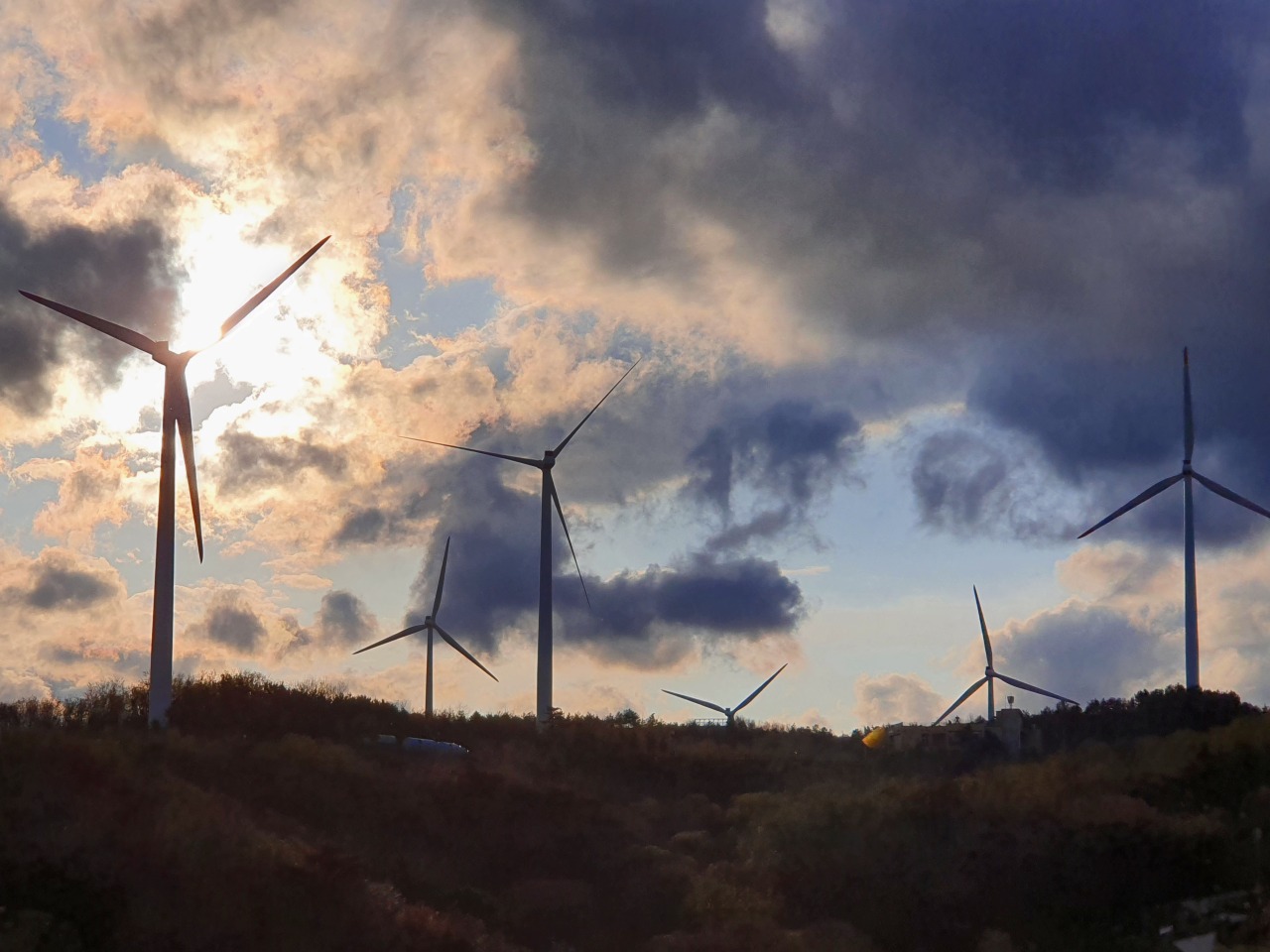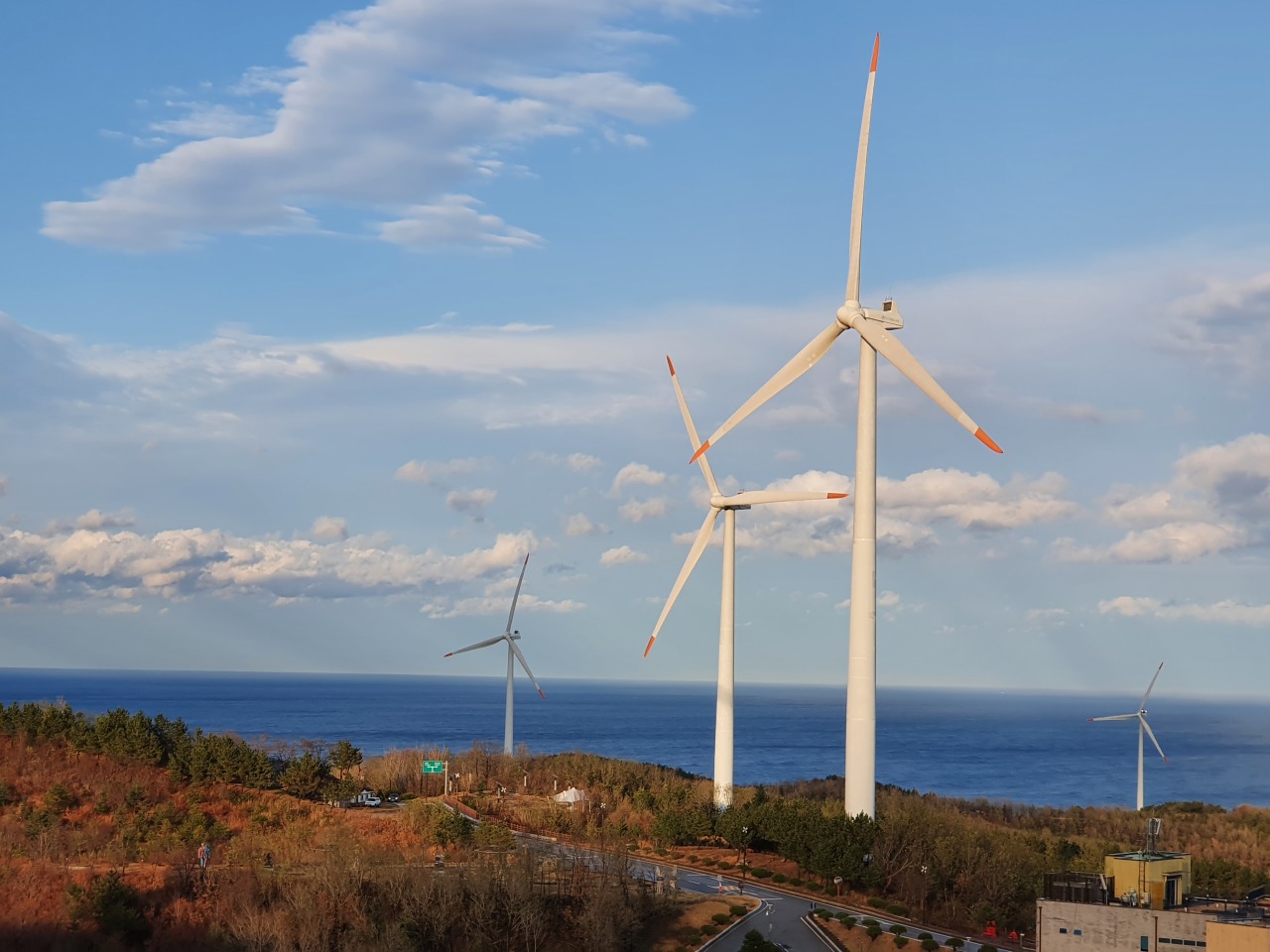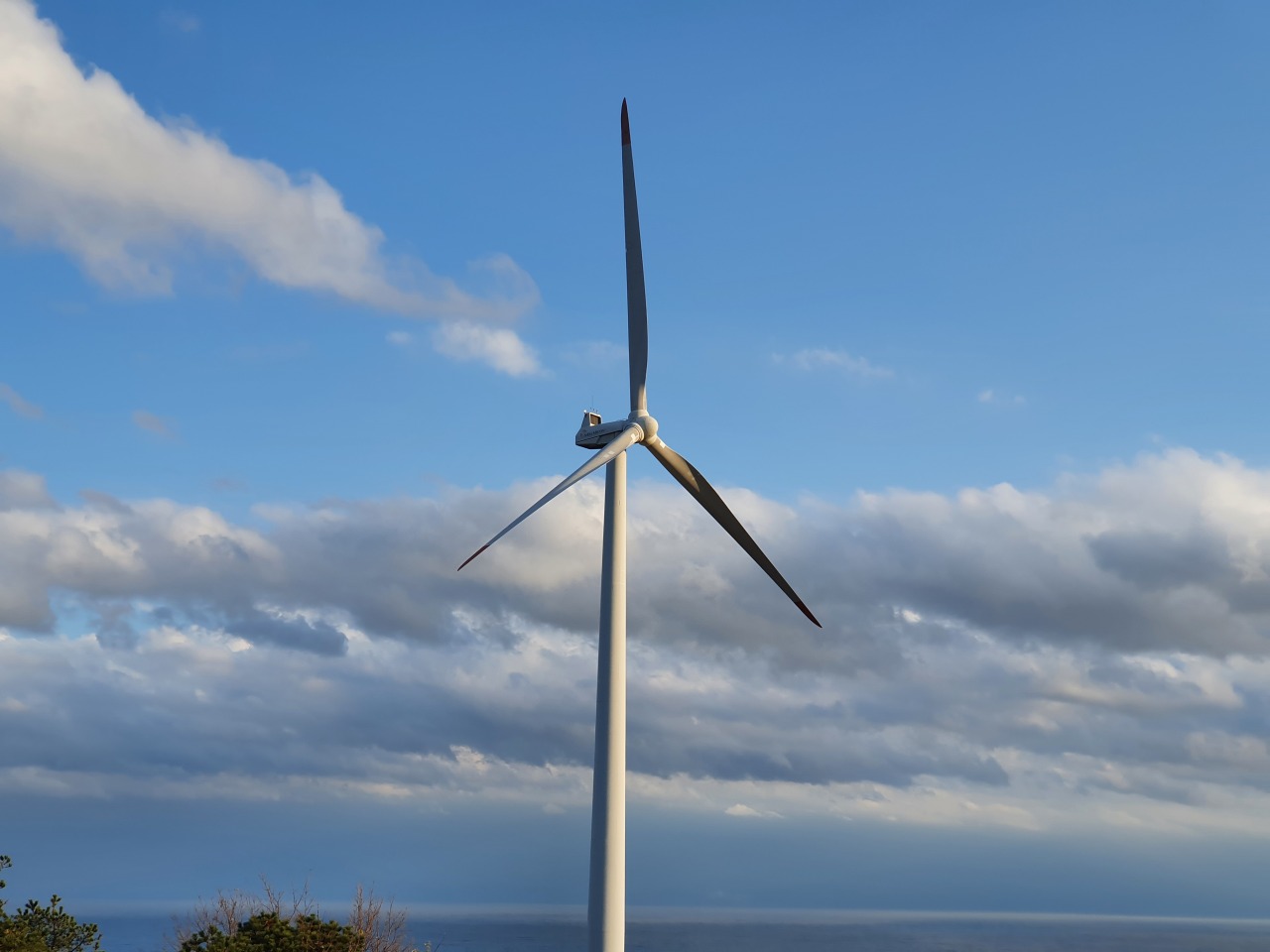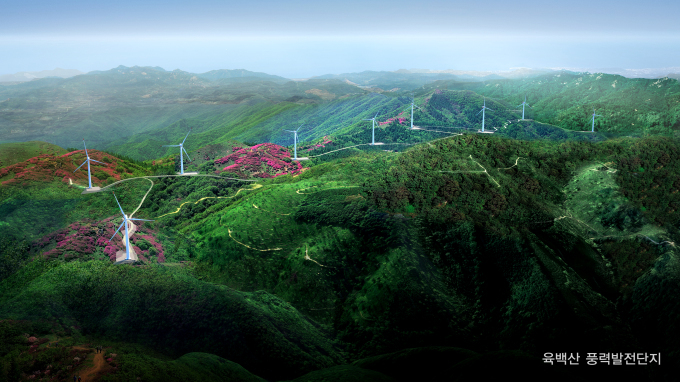 |
Wind turbines installed at Yeongdeok Wind Farm are in operation. (Kim Byung-wook/The Korea Herald) |
YEONGDEOK, North Gyeongsang Province -- Golden rays of sunlight pierced through the chunks of cotton clouds to shine across 24 giant wind turbines atop a 200-meter-tall hill.
The three blades jutting from each of the 1.65-megawatt wind turbines rotated clockwise at full throttle, powered by the sea breeze from the coast of Yeongdeok, North Gyeongsang Province.
“In the winter season from November to February, Yeongdeok Wind Farm is in full operation as strong winds from the northwest blows into the Korean Peninsula,” Lee Jin-cheol, executive vice president of Yeongdeok Wind Power, the operator of the wind farm, told a dozen reporters on the visit.
The press tour was arranged by Korea Southern Power, as the facility is a textbook example to benchmark for its own wind farm project that awaits government approval at Yukbaeksan, a 1,244-meter mountain in Samcheok, Gangwon Province.
Yeongdeok Wind Farm, which began operation in 2005, is the first-ever commercial wind farm of South Korea. Designed and constructed by Unison, a major wind turbine maker in the country, the 39.6-megawatt wind farm at a cost of 67.5 billion won ($60.4 million) offers an average operation rate of 21-23 percent, generating 7.8 gigawatts of electricity a year -- enough to power 15,800 households and cut 49,000 metric tons of carbon dioxide annually.
 |
Yeongdeok Wind Farm (Kim Byung-wook/The Korea Herald) |
Yeongdeok Wind Farm marks its 15th year of operation, which means the government’s 15-year subsidy program is also terminated as of this year. To renew the government subsidy program, the 24 wind turbines have to be taken apart and replaced with new ones.
“To reapply for subsidies, Yeongdeok Wind Farm is preparing for a repowering project, which will replace outdated 1.65-megawatt wind turbines with new ones with capacity between 4 to 6 megawatts. The exact number of new turbines hasn’t been decided yet,” said Heo Hwa-do, president and CEO of Unison.
This will potentially be Korea’s first repowering project -- anticipated to cost 2 billion to 3 billion won per megawatt -- and thus the first opportunity to prepare due recycling measures.
“Blades of wind turbines are made of carbon glass fibers, so they will have to be incinerated. However, the rest of the parts are recyclable as they are mostly made of copper and steel,” Heo said.
 |
Unison’s 1.65-megawatt wind turbine (Kim Byung-wook/The Korea Herald) |
As the first commercial wind farm and the first potential site for a repowering project in Korea, Yeongdeok Wind Farm is a perfect specimen for Kospo to study before launching its Yukbaeksan wind farm project, which aims to invest 80 billion won to roll out five 4.2-megawatt wind turbines and four 2.3-megawatt wind turbines manufactured by Unison.
Scheduled to break ground in December next year, the Yukbaeksan wind farm project, once completed, would allow Kospo to reach its goal of installing 100 Korean-made wind turbines.
 |
Architectural drawing of Korea Southern Power‘s 30-megawatt wind farm in Yukbaeksan mountain in the city of Samcheok, Gangwon Province. (Korea Southern Power) |
“Yukbaeksan wind power project will install Unison’s newly developed 4.2-megawatt wind turbines for the first time, allowing the domestically made products to accumulate a track record crucial for foreign exports,” a Kospo official said.
With a total capacity of 30 megawatts, the Yukbaeksan wind power project will generate 6.5 gigawatts of electricity a year, enough to power 18,250 households. The wind farm will also cut 42,114 tons of carbon dioxide each year, akin to curbing the carbon emitted by 17,547 cars or planting 10 million 20-year old pine trees. In terms of costs, the wind farm can save 3.4 billion won in coal used for a coal-fired plant in a year.
Though Kospo and Unision were granted a business license to proceed with the project in 2016, it has been stalled for more than four years due to regulations that have been too slow to catch up with the fast-growing renewable energy industry.
The first obstacle emerged in 2017, when the National Institute of Ecology under the Ministry of Environment said the construction site must be preserved for environmental reasons. The NIE is the organization that draws up the Ecosystem and Nature Map, showing which land can and cannot be developed. First grade zones must be preserved and cannot be developed. Second grade zones are negotiable, while third grade zones are available for development.
The site for the Yukbaeksan project, which was previously a second grade zone, was upgraded to a first grade zone by the NIE in 2017. According to the NIE, the site holds geological value as a high-level planation surface, or flat land on top of a mountain.
More challenges came from the Korea Forest Service, which issues permits for the use of mountain forests. It said the site for the Yukbaeksan project included forest areas that had been timbered recently, making the site ineligible for an economic development as young trees had been replanted just years ago.
Kospo and Unison could have purchased privately owned land for the Yukbaeksan project, but such privately owned land is usually in the vicinity of local towns and would potentially trigger conflicts with local residents.
Despite the regulatory hurdles, building the wind farm on top of a 1,200-meter mountain offers various strategic advantages.
In addition to the project being supported by nearby residents, as wind blows faster in high altitudes, the Yukbaeksan project can expect greater profits with an average wind speed up to 7 kilometers per hour compared to the Yeongdeok Wind Farm’s 6 kilometers per hour.
“The Korea Ministry of Government Legislation is currently reviewing forestry laws to soften regulations on the use of state-owned mountain forests to foster the domestic onshore wind power industry,” Park said.
Due to a series of regulations, Kospo and Unison downsized the Yukbaeksan project to nine wind turbines from 15 wind turbines.
For a typical wind power unit to turn profit, it takes seven to nine years, according to Unison.
By Kim Byung-wook (
kbw@heraldcorp.com)











